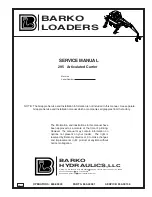
Typified by ideally matched materials and fully developed design
details, Parker ORIGA cylinders have a very long operational life.
However, the service life may be reduced by extreme and demanding
environmental conditions. Therefore, occasional maintenance is
recommended.
Upgrade Kit:
an upgrade kit should be used when you are upgrading
an old Series 2000 cylinder, into a Revised Series 2000 cylinder.
After dismantling the cylinder, all existing components can be put to
the side, except for the barrel (item #1). An upgrade kit contains all of
the components needed to re-build a cylinder, except for the barrel.
Service Pack & Seal Kit:
a service pack or seal kit should be used
when you are repairing a Revised Series 2000 cylinder. A Revised
cylinder can be defined as any cylinder manufactured after January
2002 or any cylinder that has already received an upgrade kit. After
dismantling the cylinder, all existing components should be kept close.
Many of these components will be re-used.
This assembly process describes the steps needed to upgrade an old
Series 2000 cylinder, into a Revised Series 2000 cylinder. Some
steps or procedures can be eliminated or modified, if you already
have a Revised Series 2000 cylinder, because you will be re-using
many of the older components.
Dismantling The Cylinder:
Comply with local safety regulations:
1. Disconnect air and electrical supplies.
2. Remove cylinder from framework.
3. Remove the piston mounting (item #10), by removing the piston
mount screws (item #5).
4. Loosen the outer bandlock screws (item #6).
5. Loosen the inner bandlock screws (item #29).
6. Remove the end cap screws and remove both end caps.
7. Remove the cushion pipes (item #19). You can use the piston as a
tool, to lightly tap them free. This step is for the upgrade kits only.
The cushion pipes are physically attached to the end cap, on the
Revised Series 2000 cylinder.
8. Remove the piston (item #7). The inner band should come out with
the piston (item #3).
Fitting The Piston:
1. Support Rings: kits include 3 sets of support rings (item #8). The
support rings are colored white, red, and green. Each color
represents a different thickness. White is the thinnest, green is the
thickest and red is in the middle. If the cylinder you are re-building
already uses this style of support ring, the cylinder can be re-built
using the same color. If not, each support ring should be inserted
into the barrel, to determine which fit is best for your particular
barrel. Start with the thickest support ring (green) and move down.
The support ring should have minimum play, but should still offer
free movement inside the barrel.
2. Attach one of the support rings (item #8), to one end of the piston
(item #7).
3. Magnet: insert the magnet components into the piston (item #7).
The steel magnet holder is inserted first (item #14B). The magnet is
inserted next (item #13). The aluminum magnet holder is inserted
last (item #14A).
4. Attach the remaining support ring (item #8), to the other end of the
piston (item #7). Work with the support rings, until they clip
together. The support rings, on both ends of the piston, will hold
the magnet assembly in place.
5. Slide Shoe: kits include 3 sets of slide shoes (item #9). The slide
shoes are colored yellow, tan, and black. Each color represents a
different thickness. Yellow is the thinnest, black is the thickest and
tan is in the middle. If the cylinder you are re-building already uses
this style of slide shoe, the cylinder can be re-built using the same
color. If not, put a slide shoe on one end of the piston. Insert the
piston into the barrel, to determine which fit is best for your
particular barrel. Start with the thinnest slide shoe (yellow) and
move up. The slide shoe should have minimum play, but should still
offer free movement inside the barrel.
6. Attach the slide shoes (item #9) to both ends of the piston (item
#7). You may need to work with the slide shoes, until they clip
together.
7. Attach the side wipers (item #12) to both sides of the piston (item
#7). When installing the side wipers, make sure they flair out,
away from the piston. A needle nose pliers may be useful when
installing this item. The side wipers may need to be trimmed with a
scissors, to make sure they are flush with the end of the piston.
8. Cushion Seal: apply grease to the face of the support rings (item
#8) and to both cushion seals (item #16). Insert the cushion seals
to both ends of the piston.
9. Piston Seal: apply grease to the support ring on one end of the
piston (item #8) and to one of the piston seals (item #15). Attach a
piston seal to that support ring.
Inner Band:
1. Inner Band: slide the inner band (item #3) through the piston (item
#7). Insert the inner band, with the beveled edge side facing
down. Pull the inner band forward, so there is an equal amount
extending from both ends of the piston. If necessary, assemble the
rivet to the end of the inner band (25mm bore only).
Greasing:
1. Completely coat the piston assembly with grease, including the
support rings, slide shoes, piston seals, and cushion seals.
2. Insert the piston (item #7) into the barrel (item #1). The piston end,
16
Assembly Instructions (Series 2000)
Summary of Contents for ORIGA P120 Series
Page 1: ...Assembly Instructions Series P120 Series P210 and Series 2000...
Page 2: ...2 Assembly Instructions Series 2000 and Series P210 16 Series P120 40 80mm 10mm...
Page 3: ...3 Assembly Instructions Series P120 Series P210 Series 2000 Series P210 and Series 2000...
Page 4: ...Assembly Instructions 4...
Page 5: ...Assembly Instructions 5...
Page 13: ...13...





































